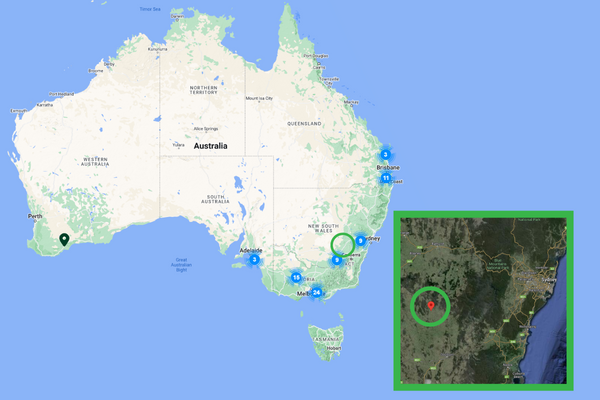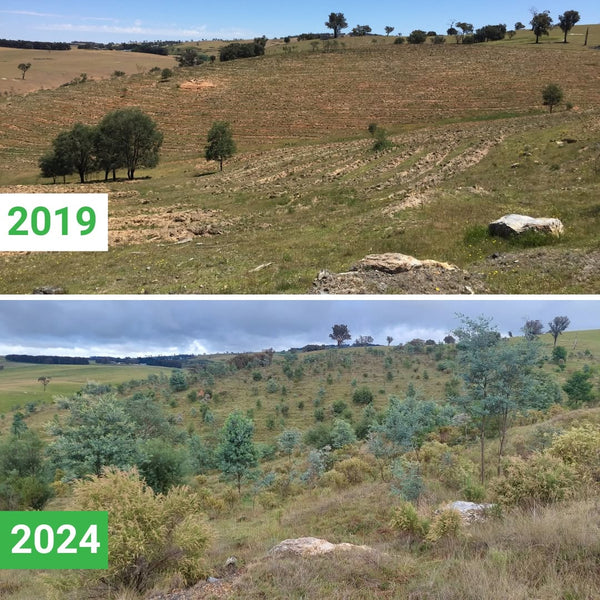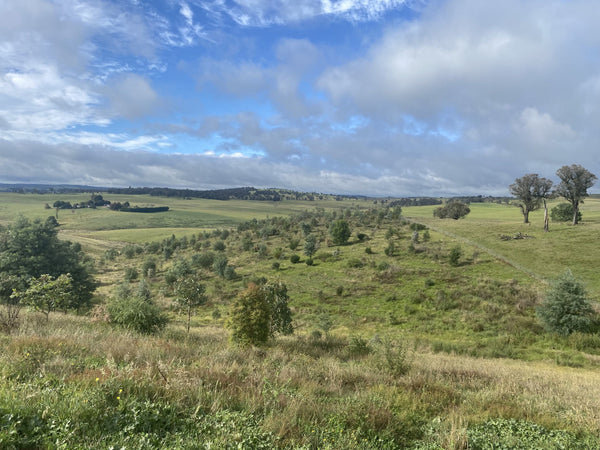Increasing Land Productivity, Delivering Diversity And Climate Action
Growing on Dharug land, in the Central Tablelands of New South Wales, Turkey Hill demonstrates how Greenfleet and farmers can work together to improve land productivity while delivering critical climate action.
The forest growing at Turkey Hill will improve soil quality as it grows, while protecting the property’s livestock, and providing potential habitat to the region’s birds and wildlife.

Location & Map
This revegetation project is growing near Limerick, approximately 100km north of Canberra. Biodiversity restoration is critical in this region known for its agricultural industries. By restoring parts of this working farm, Greenfleet is demonstrating that agriculture can coincide with climate action.
This is one of Greenfleet’s many projects in New South Wales, you can see where other Greenfleet projects are located in Australia and New Zealand here.

Local Species Selection
Since 2019, Greenfleet has been revegetating the property to restore land previously cleared for farming, returning 15 hectares to biodiverse native forest.
The property had been previously cleared for grazing and was in poor ecological condition with only seven native species found on it. Greenfleet planted an additional 22 locally native species to bolster the existing vegetation to expand the ecological diversity and improve soil quality.
Species planted include yellow box (Eucalyptus melliodora), red box (Eucalyptus polyanthemos), silver wattle (Acacia dealbata) and river bottlebrush (Callistemon paludosus). These, along with other native species planted, were and carefully selected to restore the biodiversity and increase the land’s productivity.

Revegetation Approach
To deliver climate action and increase land productivity, three shelter belts and three block plantings have been established. As these areas grow, they are providing protection for the livestock and restoring parts of this mostly barren landscape. In partnership with the South East Local Land Service of NSW, fencing was erected to protect the saplings from grazing animals as they grow.
Key benefits of this project are improving water and soil quality, which in turn is expanding the species selection that will increase the area’s biodiversity for future generations.
Site preparation is a vital step in our approach to revegetation. Prior to planting, the land at Turkey Hill was ripped. This technique enables the retention of rainwater and allows for water to penetrate the soil to root depth.
Climate Action
The forest growing at Turkey Hill is legally protected for 100 years with an on-title agreement. This ensures the impact being made is long-term and sustainable.
Over its lifetime, the forest will remove over 12,500 tonnes of carbon from the atmosphere. Greenfleet uses the CSIRO’s Full Carbon Accounting Model (FullCAM) to measure the carbon uptake at each of our revegetation sites.
The amount of carbon being removed at Turkey Hill is equivalent to capturing a year’s worth of emissions from about 2,900 average sized cars.
Location Size
15 hectares in the Central Tablelands of NSW
Planting Dates
2019
Species
- Blakely's red gum (Eucalyptus blakeyii)
- Apple box (Eucalyptus bridgesiana)
- Long-leaved box (Eucalyptus goniocalyx)
- Red stringybark (Eucalyptus macroryncha)
- Yellow box (Eucalyptus melliodora)
- Red box (Eucalyptus polyanthemos)
- Inland scribbly gum (Eucalyptus rossii)
- Silver wattle (Acacia dealbata)
- Spearwood (Acacia doratoxylon)
- Lightwood (Acacia implexa)
- Red-stem wattle (Acacia rubida)
- Varnish wattle (Acacia verniciflua)
- Blackthorn (Bursaria spinosa)
- Box-leaved wattle (Acacia buxifolia)
- Spreading wattle (Acacia genistifolia)
- Kangaroo thorn (Acacia paradoxa)
- River bottlebrush (Callistemon paludosus)
- Narrow-leaf bitter-pea (Daviesia leptophylla)
- Spiny bush-pea (Pultenaea spinosa)
- Sticky hop bush (Dodonaea viscosa)
- Common hovea (Hovea heterophylla)
- Violet kunzea (Kunzea parvifolia)


